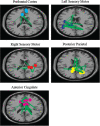Walking reduces sensorimotor network connectivity compared to standing
- PMID: 24524394
- PMCID: PMC3929753
- DOI: 10.1186/1743-0003-11-14
Walking reduces sensorimotor network connectivity compared to standing
Abstract
Background: Considerable effort has been devoted to mapping the functional and effective connectivity of the human brain, but these efforts have largely been limited to tasks involving stationary subjects. Recent advances with high-density electroencephalography (EEG) and Independent Components Analysis (ICA) have enabled study of electrocortical activity during human locomotion. The goal of this work was to measure the effective connectivity of cortical activity during human standing and walking.
Methods: We recorded 248-channels of EEG as eight young healthy subjects stood and walked on a treadmill both while performing a visual oddball discrimination task and not performing the task. ICA parsed underlying electrocortical, electromyographic, and artifact sources from the EEG signals. Inverse source modeling methods and clustering algorithms localized posterior, anterior, prefrontal, left sensorimotor, and right sensorimotor clusters of electrocortical sources across subjects. We applied a directional measure of connectivity, conditional Granger causality, to determine the effective connectivity between electrocortical sources.
Results: Connections involving sensorimotor clusters were weaker for walking than standing regardless of whether the subject was performing the simultaneous cognitive task or not. This finding supports the idea that cortical involvement during standing is greater than during walking, possibly because spinal neural networks play a greater role in locomotor control than standing control. Conversely, effective connectivity involving non-sensorimotor areas was stronger for walking than standing when subjects were engaged in the simultaneous cognitive task.
Conclusions: Our results suggest that standing results in greater functional connectivity between sensorimotor cortical areas than walking does. Greater cognitive attention to standing posture than to walking control could be one interpretation of that finding. These techniques could be applied to clinical populations during gait to better investigate neural substrates involved in mobility disorders.
Figures





References
-
- Friston KJ, Holmes AP, Worsley KJ, Poline JP, Frith CD, Frackowiak RSJ. Statistical parametric maps in functional imaging: a general linear approach. Hum Brain Mapp. 1994;2:189–210. doi: 10.1002/hbm.460020402. - DOI
-
- Eguiluz VM, Chialvo DR, Cecchi GA, Baliki M, Apkarian AV. Scale-free brain functional networks. Phys Rev Lett. 2005;94:018102. - PubMed
Publication types
MeSH terms
LinkOut - more resources
Full Text Sources
Other Literature Sources
Miscellaneous

